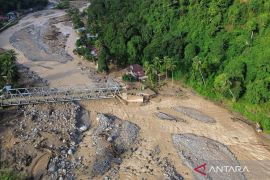La Nina is expected to last until mid-February 2022, with high rainfall intensity and floods forecast in some areas, he noted.
"In these four provinces, on the district and city level, please start to be aware of the mitigation of La Nina's impact," Warsito said at the La Nina Coordination Meeting and Preparation on Thursday.
Data have shown that of the 17,032 disasters recorded in 2016-2020, most were wet hydro-meteorological disasters such as floods, landslides, and extreme weather, he pointed out.
Seven provinces recorded the highest number of disasters—Aceh, West Sumatra, West Java, Central Java, East Java, South Kalimantan, and South Sulawesi, he informed.
Meanwhile, in 2021, until November 3, as many as 2,242 disasters have been reported, with floods, landslides, and tornadoes accounting for most of them, Warsito said.
The districts and cities in Indonesia that need to remain alert in West Java include Bogor, Sukabumi, Bandung, and West Bandung, he said.
Meanwhile, in Central Java,Cilacap, Semarang, Banyumas, Magelang, and Wonogiri need to be alert, he added.
Furthermore, in East Java, Ponorogo, Trenggalek, Situbondo, Jember, and Nganjuk need to be on the lookout for disasters, he said.
Related news: Anticipatory steps key to tackle La Nina events: BMKG
In South Sulawesi, Banreng, Barru, Bone, Bulukumba, and Enrekang need to anticipate disasters linked to La Nina, he added.
These districts and cities have been asked to stay alert since disasters were often reported in these areas in the 2016-2020 period, he said.
Warsito also asked all parties to remain aware of hydro-meteorological disasters triggered by the La Nina phenomenon, which is coinciding with the peak of the rainy season.
"We have to know the threat so that we can determine the strategy to deal with the disaster. I am sure each Regional Disaster Mitigation Agency (BPBD) has made a contingency plan," he remarked.
Warsito said he has issued directions for anticipating the impact of La Nina to BPBDs in all regions. The directions include conducting preparation meetings, preparing contingency plans, establishing emergency alert status, and conducting preparation activity, he added.
BPBDs in all regions also need to strengthen community-based early warning systems and ensure early warning communication networks are functional, he said.
"This communication system is very important; it is the key player of disaster management. Coordination through communication is important to become a synergy between various ministries and institutions," Warsito pointed out.
In addition, to mitigate the potential for wet hydro-meteorological disasters, Warsito urged stakeholders, including the community, to start planting vegetation, cleaning waterways, strengthening river embankments, strengthening slopes using both concrete and vegetation, maintaining surface drainage, and cutting weathered trees.
Then, efforts to prepare for potential disasters include observing warnings from the Meteorology, Climatology and Geophysical Agency (BMKG), establishing evacuation routes, establishing signs for disaster-prone areas, creating community-based early warning systems, creating community-based communication networks, and conducting evacuation simulations, he added.
Related news: BMKG issues warning of extreme weather in parts of Indonesia
Translator: Devi Nindy, Resinta S
Editor: Rahmad Nasution
Copyright © ANTARA 2021












